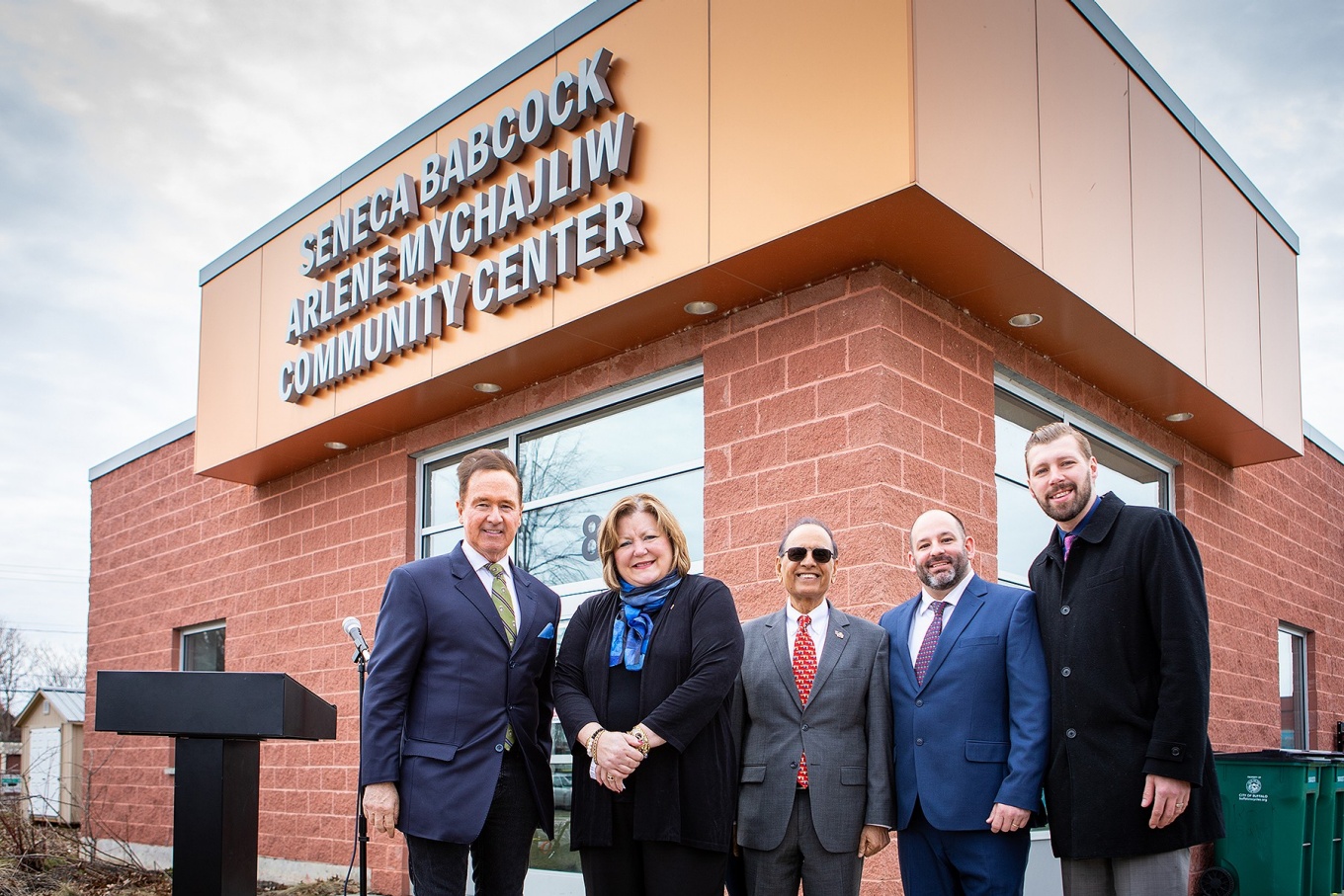campus news
UB receives federal funding to support mobile health unit

Attending an announcement of federal funding awarded to the School of Public Health and Health Professions to support a mobile health unit are (from left) Rep. Brian Higgins; SPHHP Dean Jean Wactawski-Wende; President Satish K. Tripathi; Brian Pilarski, executive director, Seneca Babcock Community Association; and Buffalo Common Council member Bryan Bollman. Photo: Douglas Levere
By DAVID J. HILL
Published March 24, 2023
More than half of the residents who make up Buffalo’s Seneca Babcock neighborhood don’t have a vehicle. That makes getting to medical appointments, and just about anything health care related, challenging.
But through a community partnership forged several years ago with neighborhood leaders, the School of Public Health and Health Professions (SPHHP) has big plans to break down the two biggest barriers residents face: transportation and access.
The project received a major boost Wednesday when Rep. Brian Higgins announced $933,800 in federal funding awarded to SPHHP to support a mobile health unit that will provide much-needed access and services, not only to Seneca Babcock, but other medically underserved communities in Erie, Niagara and surrounding counties.
“Healthy lifestyles begin with access to health care. From regular appointments with primary care physicians, to enrolling in affordable coverage, far too many people living in Western New York’s underserved communities lack access to the resources to address their health care needs,” Higgins said.
“The University at Buffalo’s mobile health clinic will build on existing partnerships to meet members of our community in greatest need where they live to provide comprehensive care. Thanks to this critical funding secured in the federal budget, we can eliminate barriers to care and make a long-term investment in a healthier future for our community.”
Higgins announced the federal funding at a news conference outside the Seneca Babcock Arlene Mychajliw Community Center, where he was joined by President Satish K. Tripathi and SPHHP Dean Jean Wactawski-Wende, as well as city and community leaders.
“As a public research university, UB is driven by our mission to partner with the members of our community so we can better understand — and best address — the health needs of our region,” Tripathi said. “By focusing on the needs of our neighbors who are medically underserved, we will work in concert with our community to achieve health equity — a goal that we have long shared with Congressman Higgins.”
The mobile health unit still needs to be built. Project partners are working with the manufacturer on the design and build-out of the van, which will be of similar size to the mobile units the School of Dental Medicine runs as part of its S-Miles To Go program. SPHHP’s mobile unit will feature rooms for medical exams and a patient interview area.
The Mother Cabrini Foundation earlier this year awarded SPHHP $600,000 for the mobile health unit. That, coupled with the federal funding Higgins secured, will be enough to build and staff the unit, bringing to fruition a longtime goal.
“We have dreamed for many years about the possibility of setting up a free clinic in this neighborhood. The funding provided by Congressman Higgins will bring this medical mobile unit to our community to help break down some of those barriers,” Wactawski-Wende said.
From the mobile clinic, UB health sciences students and faculty will be able to offer health screenings and prevention services, provide referrals to primary care providers and help individuals and families navigate the health care system, from getting connected with health insurance providers to finding a specialist.
“We know there are a lot of chronic health conditions and not everyone in Seneca Babcock has access to health care and health insurance,” said Jessica Kruger, clinical associate professor in the Department of Community Health and Health Behavior. “This will provide a way to bridge those gaps.”
Kruger sees the mobile unit as a great opportunity to provide much-needed services to the community, while offering interprofessional education opportunities for UB’s health sciences students, including those in dental medicine, medicine, nursing, pharmacy, public health and health professions, and social work.
Stationed at the Seneca-Babcock Community Association, the mobile unit will serve a wide range of about 30,000 constituents in the city of Buffalo. UB will also work to establish partnerships with agencies in Erie and Niagara counties to regularly make the mobile health unit available to low-income residents living in both urban and rural areas across Western New York.
“Funding for this mobile unit will have tangible impact on the Seneca Babcock neighborhood and other underserved communities throughout Western New York,” Wactawski-Wende said. “We hope this program will serve as a national model of a successful and positive collaboration that can impact all the communities that we serve.”
Kruger and her students have developed a strong partnership with Seneca Babcock residents in the past few years through operating a weekly food pantry and offering free physical days for school-aged children, as well as cooking demonstrations and nutrition guidance.
UB plans to expand its programming in Seneca Babcock to be ready for when the mobile health unit is up and running.
The services the unit will provide are exactly what community members need, said Art Robinson, who has served as block club president in Seneca Babcock for the past 23 years.
“We’ve tried a lot of things, but this is one thing that is a step that is going to enhance the quality of life for people who live here,” he said.